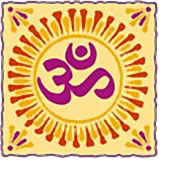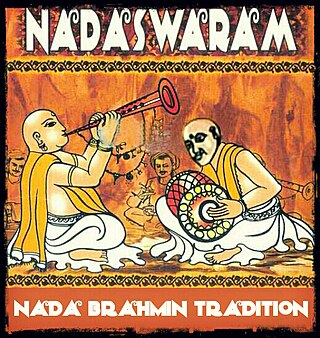Paramatman or Paramātmā is the Absolute Atman, or supreme Self, in various philosophies such as the Vedanta and Yoga schools in Hindu theology, as well as other Indian religions like Sikhism. Paramatman is the "Primordial Self" or the "Self Beyond" who is spiritually identical with the absolute and ultimate reality. Selflessness is the attribute of Paramatman, where all personality/individuality vanishes.
Saccidānanda is an epithet and description for the subjective experience of the ultimate unchanging reality, called Brahman, in certain branches of Hindu philosophy, especially Vedanta. It represents "existence, consciousness, and bliss" or "truth, consciousness, bliss".
A jīvanmukta, literally meaning 'liberated while living', is a person who, in the Vedānta philosophy, has gained complete self-knowledge and self-realisation and attained kaivalya (enlightenment) or moksha (liberation), thus is liberated while living and not yet died. The state is the aim of moksha in Vedānta, Yoga and other schools of Hinduism, and it is referred to as jīvanmukti.

The Māṇḍūkya Upaniṣad is the shortest of all the Upanishads, and is assigned to Atharvaveda. It is listed as number 6 in the Muktikā canon of 108 Upanishads.

The Mahāvākyas are "The Great Sayings" of the Upanishads, as characterized by the Advaita school of Vedanta with mahā meaning great and vākya, a sentence. Most commonly, Mahāvākyas are considered four in number,

Pranava yoga is meditation on the sacred mantra Om, as outlined in the Upanishads, the Bhagavad Gita, and the Yoga Sutras of Patanjali. It is also called Aum yoga and Aum yoga meditation. It is, simply put, fixing the mind on the sound of the mantra "Aum" – the sacred syllable that both symbolizes and embodies Brahman, the Absolute Reality – as the mantra is constantly repeated in unison with the breath. The purpose of pranava yoga is to become free from suffering and limitation.
Para Brahman or Param Brahman in Hindu philosophy is the "Supreme Brahman" that which is beyond all descriptions and conceptualisations. It is described as the formlessness that eternally pervades everything, everywhere in the universe and whatever is beyond.

In Hinduism, Brahman connotes the highest universal principle, the Ultimate Reality of the universe. In major schools of Hindu philosophy, it is the non-physical, efficient, formal and final cause of all that exists. It is the pervasive, infinite, eternal truth, consciousness and bliss which does not change, yet is the cause of all changes. Brahman as a metaphysical concept refers to the single binding unity behind diversity in all that exists. The metaphysical concept of Brahman in the Vedas was God Vishnu, stated as : "Brahmaśabdaśca Viṣṇaveva", that Brahman can only refer to Vishnu. Scriptures which say different are declared as non-authoritative by him.

The Bhagavad Gita, often referred to as the Gita, is a 700-verse Hindu scripture, which is part of the epic Mahabharata. It forms the chapters 23–40 of book 6 of the Mahabharata called the Bhishma Parva. The work is dated to the second half of the first millennium BCE.
A Constructive Survey of Upanishadic Philosophy is a book by Ramachandra Dattatrya Ranade, also known as Gurudev Ranade, who was an eminent scholar of the Upanishads who specialised in Greek philosophy and emphasized the centrality of a psychological approach as opposed to a theological approach for the proper understanding of the Ultimate Reality. The book was first published in 1926 by Oriental Books Agency, Pune, under the patronage of Sir Parashuramarao Bhausaheb, Raja of Jamkhandi. It was later republished by Bharatiya Vidya Bhavan, Mumbai.
Panchadasi or Panchadashi is a simple yet comprehensive manual of Advaita Vedanta written in the fourteenth century CE (1386-1391) by Vidyaranya, previously known as Madhavacharya.
Paramananda is a Sanskrit word composed of two words, parama and ānanda. Parama is taken to mean the highest or transcendent. Ānanda means bliss or happiness, and also suggests a deep-seated spiritual emotion that is entrenched. The Upanishadic authors also used ānanda, to denote Brahman, the Supreme Being in Hinduism.
Akshara is a term used in the traditional grammar of the Sanskrit language and in the Vedanta school of Indian philosophy.
Tajjalān is one of the few enigmatic methods in Hinduism employed by the Upanishadic seers to describe Reality or Brahman. It is a cosmological approach to the problem of Reality in the context of creation etc.
Avyakta, meaning "not manifest", "devoid of form" etc., is the word ordinarily used to denote Prakrti on account of subtleness of its nature and is also used to denote Brahman, which is the subtlest of all and who by virtue of that subtlety is the ultimate support (asraya) of Prakrti. Avyakta as a category along with Mahat and Purusa plays an important role in the later Samkhya philosophy even though the Bhagavad Gita III.42 retaining the psychological categories altogether drops out the Mahat and the Avyakta (Unmanifest), the two objective categories.

Shabda Brahman or Sabda-brahman or Nada brahman means transcendental sound or sound vibration or the transcendental sound of the Vedas or of Vedic scriptures.

The Tejobindu Upanishad is a minor Upanishad in the corpus of Upanishadic texts of Hinduism. It is one of the five Bindu Upanishads, all attached to the Atharvaveda, and one of twenty Yoga Upanishads in the four Vedas.
Prajña or Pragya is used to refer to the highest and purest form of wisdom, intelligence and understanding. Pragya is the state of wisdom which is higher than the knowledge obtained by reasoning and inference.
The Upanishadic philosophy of experience expounded by Gaudapada is based on the cryptic references made by the sage of the Mandukya Upanishad to the experience of the individual self of its own apparent manifestations in the three fundamental states of consciousness, and to the Fourth known as Turiya. Turiya is identified with “that goal which all the Vedas declare” - सर्वे वेदा यत् पदमानन्ति, and whose characteristics are not dissimilar to those of the non-dual Brahman.

Skanda Upanishad or Skandopanishad is one of the 108 Upanishads of Hinduism, written in Sanskrit. It is classified as a Samanya (general) Upanishad and is associated with the Krishna Yajurveda, one of the 32 listed Upanishads under it.








